Key takeaways:
- Understanding different printing methods (offset, digital, screen) is essential for choosing the right fit for your project.
- Attention to detail in preparing print materials—file formats, color modes, and proofreading—can significantly impact quality.
- Effective communication with print vendors and managing timelines are crucial for a smooth print process.
- Prioritizing quality control throughout the printing stages helps ensure the final product meets your vision and expectations.
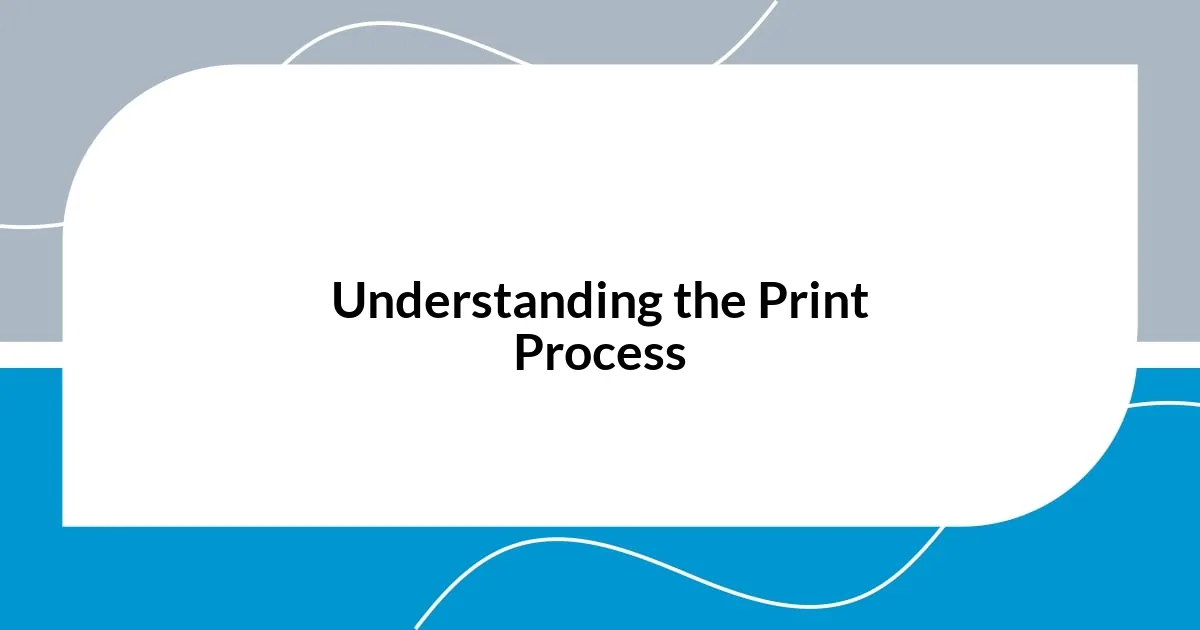
Understanding the Print Process
Understanding the print process can initially feel overwhelming, but I recently learned how rewarding it is. I remember my first time diving into this world, filled with questions like, “Where do I even start?” It turned out that breaking it down into manageable steps made everything more approachable.
When I encountered the different print methods – like offset, digital, and screen printing – it was like peeling back layers of a fascinating onion. Offset printing was the reliable workhorse, perfect for large quantities, while digital printing opened the door for flexibility. Who knew there were so many options? By experimenting with these methods firsthand, I felt a deeper connection to the art of printing.
As I progressed, I discovered the importance of prepress work, such as proofing and color management. I vividly recall the anxiety of waiting for the first proof. It wasn’t just about seeing my design on paper; it was about all my hard work coming to life. This stage taught me the critical balance between creativity and technical precision. Have you ever felt that sense of anticipation, transforming a concept into something tangible? It’s truly exhilarating.
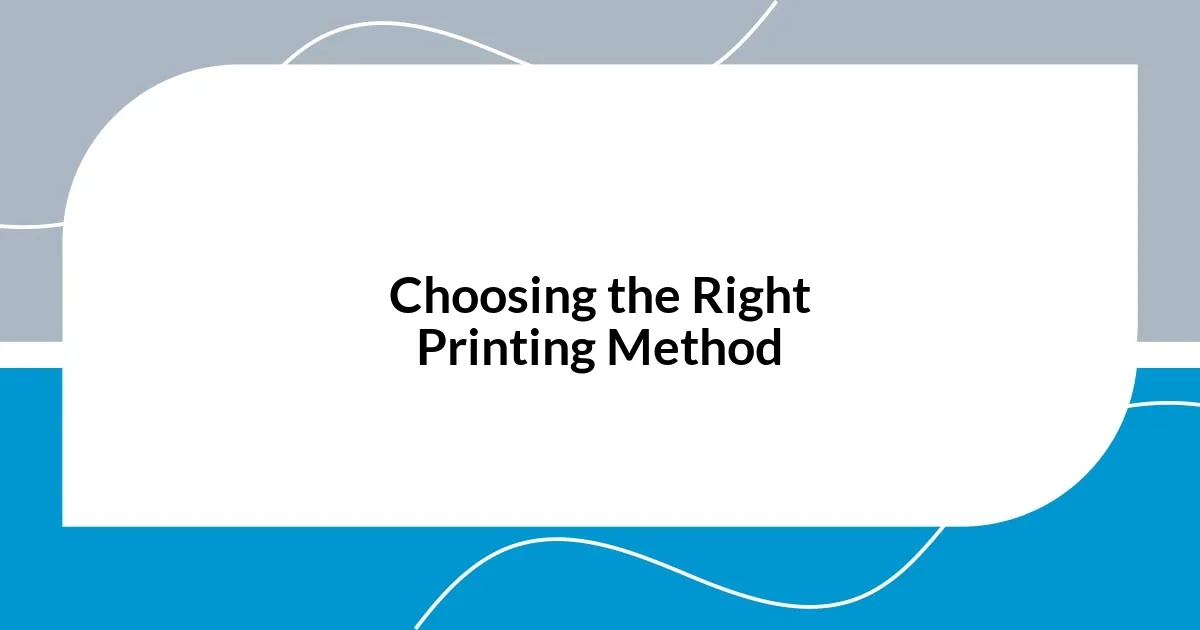
Choosing the Right Printing Method
Choosing the right printing method can significantly impact the final outcome of your project. It’s essential to consider factors like production time, budget, and quality. I recall a time when I was torn between offset and digital printing for a small run of brochures. Ultimately, I opted for digital because it allowed for quick adjustments and immediate output, perfectly fitting the tight deadline I faced.
When weighing the options, I often think about the purpose of the printed material. For example, while offset printing is superb for high-volume jobs with crisp text and vibrant colors, I’ve found short runs or unique projects thrive with digital methods. It even allows for variable data printing, so each piece can be tailored to individual recipients if needed. Have you ever had a situation where the printing method made all the difference?
To sum it up, understanding the characteristics of each printing method enables you to make an informed decision that aligns with your creative vision and logistical needs. After diving into the various printing techniques, I realized that getting the right fit for your project can feel like matchmaking—finding that perfect balance between your goals and your options.
| Printing Method | Best For |
|---|---|
| Offset Printing | High-volume projects requiring consistent quality |
| Digital Printing | Short runs and projects with fast turnaround times |
| Screen Printing | Custom apparel or unique designs |
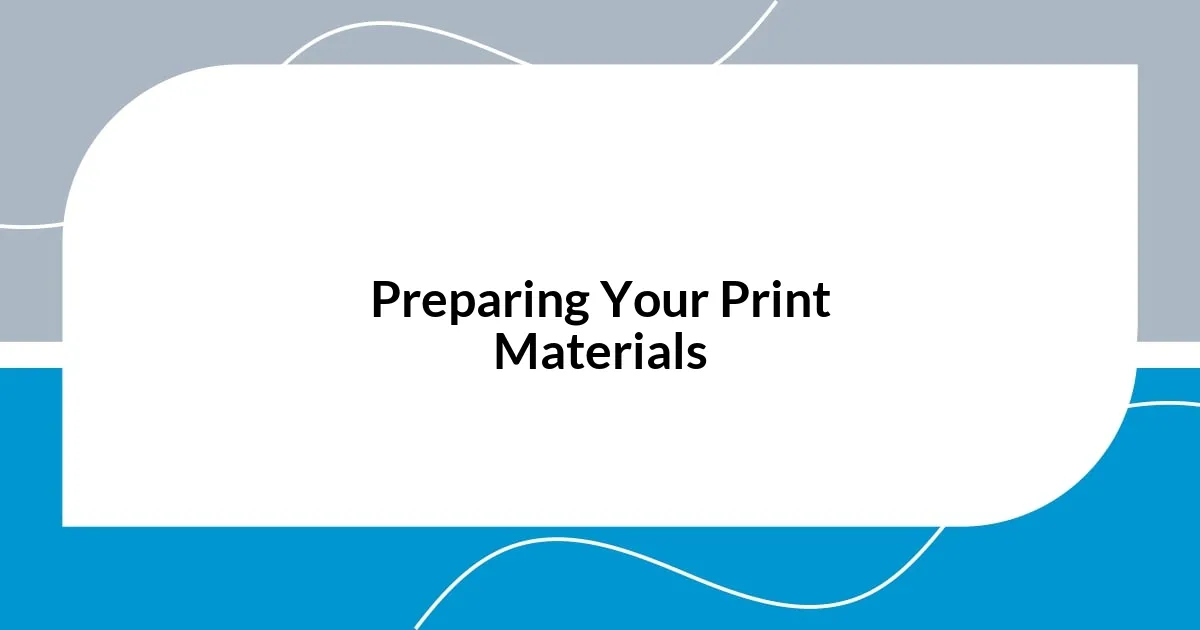
Preparing Your Print Materials
When preparing print materials, attention to detail is crucial. I’ve experienced the difference that can come from precise measurements and colors. For a recent project, I meticulously prepared the files, setting the correct dimensions to ensure everything fit beautifully on the printed page. Something about seeing the layouts line up perfectly just boosts my confidence in the whole process.
Here are some key points to remember as you prepare your materials:
- File Format: Always use high-resolution files, like PDFs or TIFFs, to maintain quality.
- Color Mode: Stick to CMYK for print to ensure colors appear as intended.
- Bleed Area: Include a bleed in your designs to avoid white edges when cut.
- Proofreading: Double, even triple-check your text—typos can feel like a personal betrayal!
- Template Use: Utilize templates provided by your printer to guarantee dimensions are spot on.
Taking these steps not only gives me peace of mind but also sets the stage for a successful print project. When I think back to when I first undervalued the prep work, I realize how vital it is. It’s not just about what looks good on screen; it’s about how much care you pour into every detail.
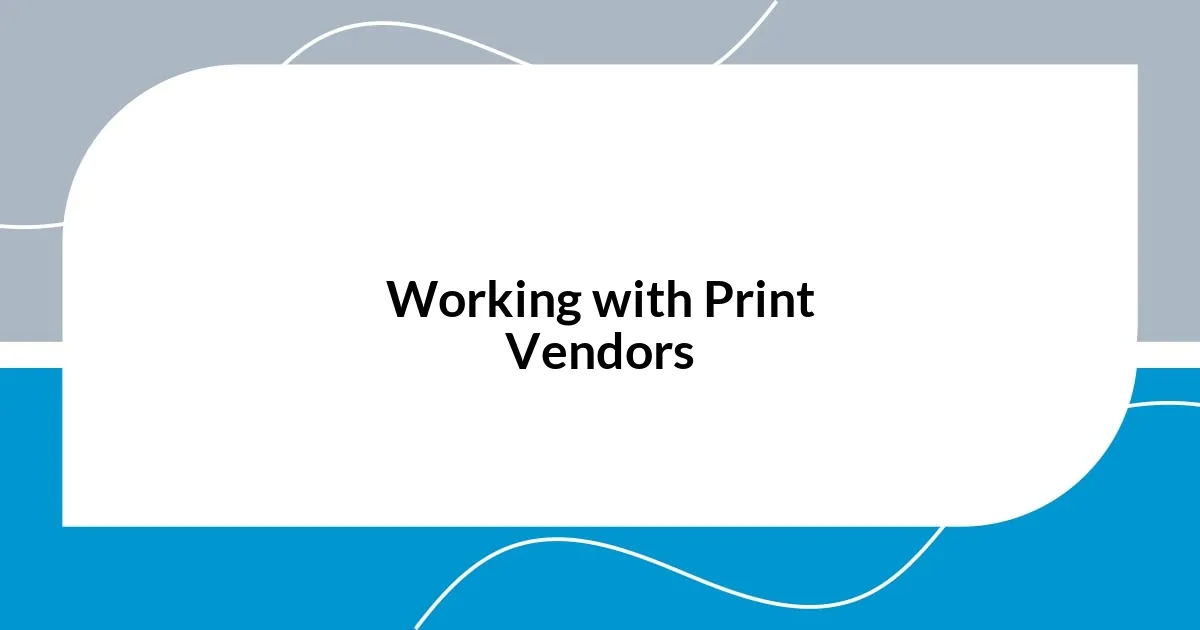
Working with Print Vendors
When I first started working with print vendors, I quickly learned that communication is key. I remember reaching out to a vendor about a project, only to realize later that I hadn’t provided enough detail. It felt like playing a game of telephone. That experience taught me the importance of being specific about my needs and expectations. As I refine my approach, I’ve found that the more transparent and detailed I am, the smoother the collaboration becomes.
Choosing the right vendor can make all the difference in the print process. I vividly recall a time when I switched to a local vendor for a time-sensitive project. The personal touch of being able to check in on the progress in person not only calmed my nerves but also fostered a more respectful partnership. Have you ever had the chance to meet your printer face-to-face? Developing that relationship can be incredibly rewarding, leading to better results and a deeper understanding of the process.
Lastly, I’ve discovered that quality over quantity should be my mantra when selecting vendors. At one point, I opted for the lowest bid, thinking I was saving money. Unfortunately, the results were subpar, and I learned a hard lesson about the true cost of cutting corners. Investing in a reliable vendor has always paid off in the long run, allowing me to focus on the creative side of my projects rather than worrying about the quality of the print. Every time I collaborate with a vendor who understands my vision, I feel supported—and that’s invaluable in the creative process.
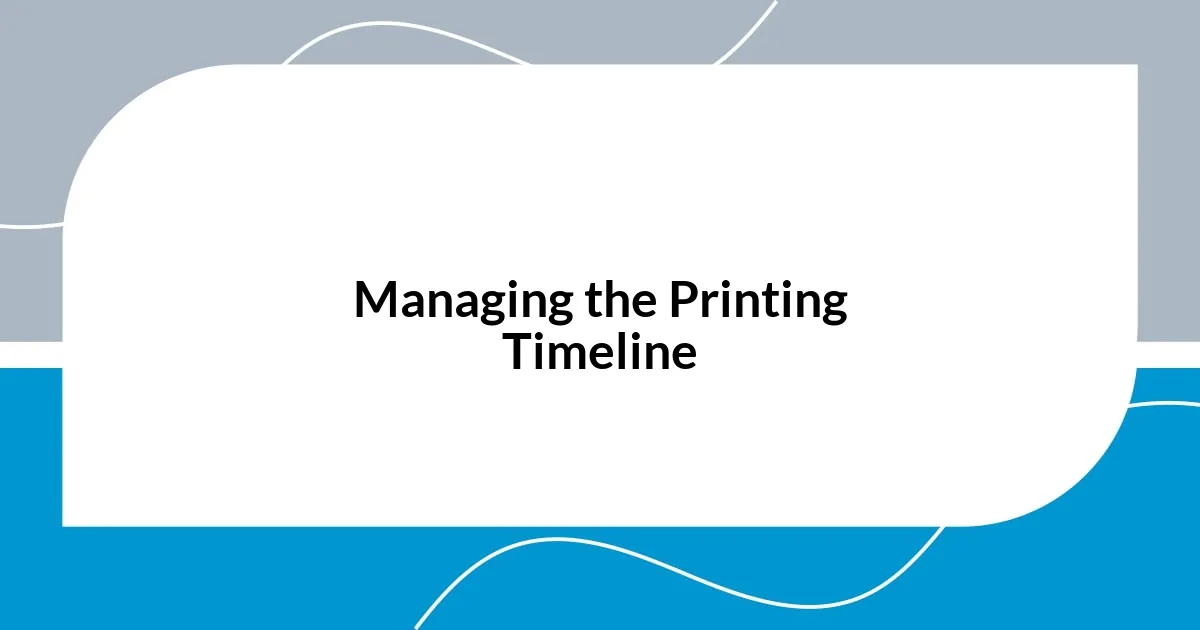
Managing the Printing Timeline
Managing the printing timeline can often feel like a juggling act, but I find that setting clear deadlines and milestones is essential. In my experience, I create a reverse timeline starting from the delivery date and working backward. This method has saved me more than once from those frantic last-minute scrambles that leave my stomach in knots.
I remember a project where I underestimated the time needed for formatting and revisions. With only a few days left until the deadline, my heart raced as I rushed to finalize everything. That taught me the hard way that including buffer time in my schedule can be a lifesaver. Now, I always build in extra time for unexpected delays, and it honestly makes the whole process feel more manageable.
Have you ever experienced a situation where a minor issue snowballed into a larger problem? I’ve had that happen with print approvals. When you communicate clearly about the review process, it significantly reduces misunderstandings. I started sending reminders to both my team and the printer about key checkpoints, and this small change has transformed the way I navigate timelines, allowing for a smoother experience overall.
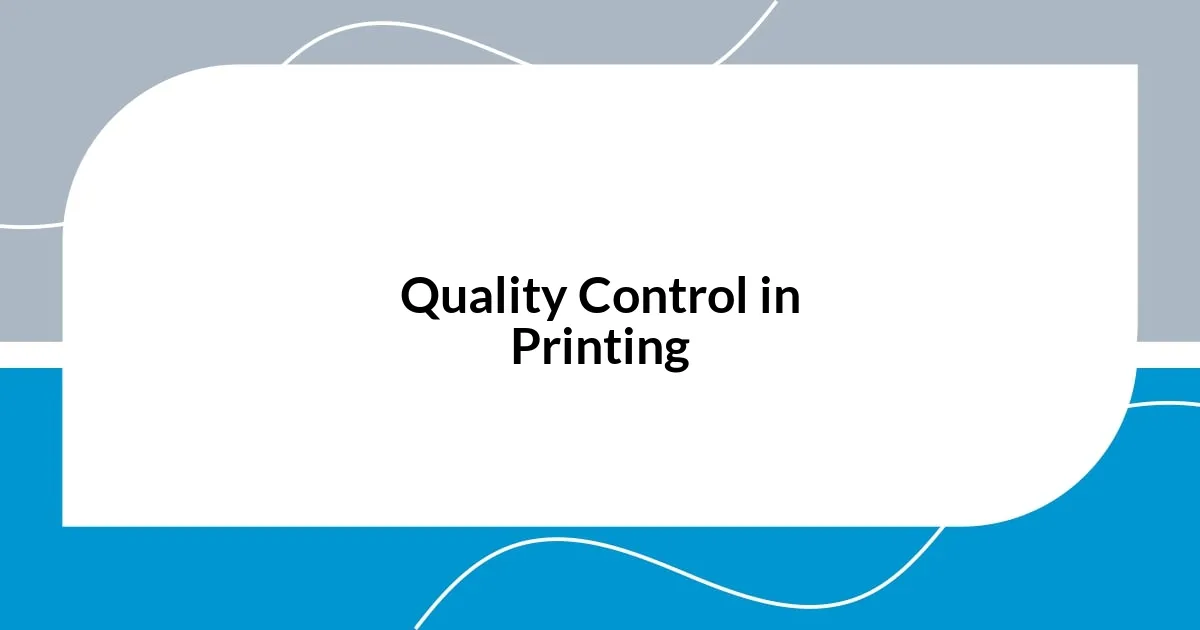
Quality Control in Printing
Quality control in printing is something I’ve come to view as the backbone of the entire process. I recall one project where I was absolutely thrilled with the design, only to be deflated when I received the printed materials. The colors were off, and the finish wasn’t what I expected. That moment was a wake-up call, highlighting the need for thorough quality checks throughout the printing stages. Have you ever received a printed piece that didn’t match your vision? It can be incredibly disheartening, which is why I now prioritize proofing.
Another key aspect of quality control is the importance of conducting pre-press inspections. I learned this the hard way during a pivotal project where I skipped this step to save time. The printer caught a significant error in the layout at the last minute, preventing what could have been a costly mistake. Now, I insist on reviewing physical prints before final production. Seeing a tangible proof not only reassures me but often reveals subtle adjustments that can elevate the final product.
Finally, finding the right balance between creativity and standard printing practices is crucial for maintaining quality. In the past, I’ve been tempted to experiment with wild designs, only to find them challenging to execute. I made a conscious effort to discuss potential limitations with my printer upfront. This proactive communication has not only helped me avoid pitfalls but has also fostered a deeper appreciation for the craft. Isn’t it fascinating how the right dialogue can enhance both the artistic vision and the print quality?
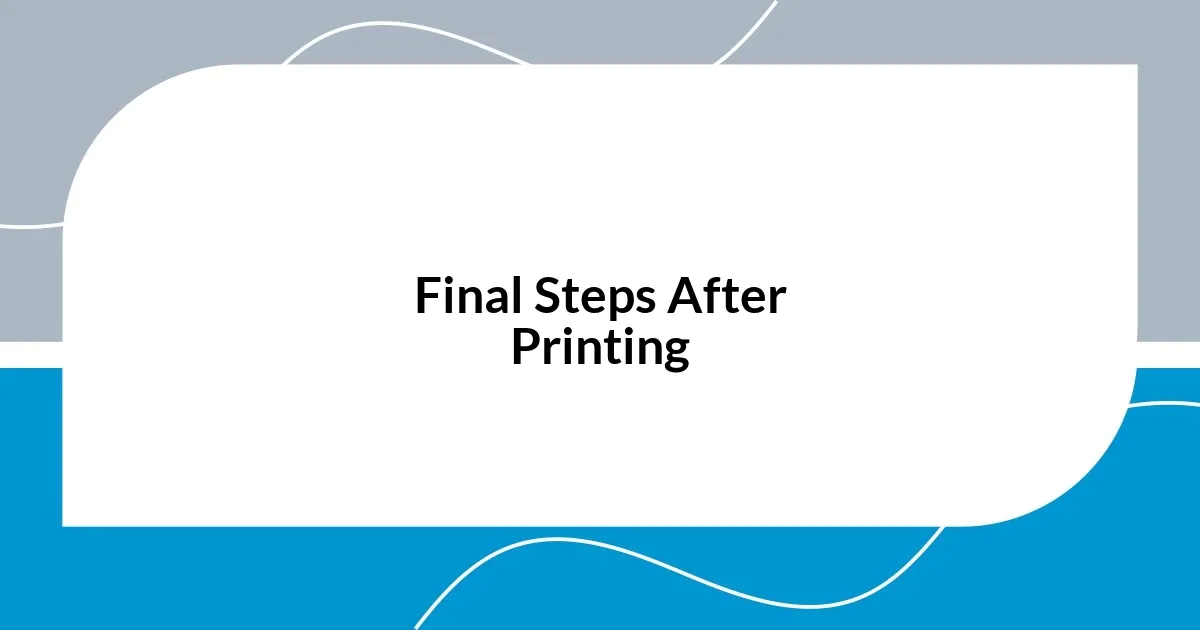
Final Steps After Printing
After the printing process wraps up, reviewing the initial batch of prints is an absolute must for me. I can still feel the excitement tinged with anxiety as I flipped through the pages of my latest project, heart racing. Did the colors pop as intended? Is every detail sharp and clear? I always set aside time to scrutinize these prints closely, feeling that initial excitement blend with a critical eye. This step is essential—it helps me catch any issues before they multiply, and there’s nothing like that euphoric moment when everything turns out just right.
Once I’m satisfied with the prints, I tackle the packaging and distribution. I remember a time when I rushed through the packing process, only to find out later that several copies had arrived damaged. That lesson was a game-changer. I now prioritize packaging that protects the prints meticulously, ensuring they arrive safely at their destination. Have you ever received a package that looked like it had been through a battle? It’s frustrating and can tarnish the experience of receiving your hard work. So, I take pride in making sure my prints are well cared for during transit, enhancing the recipient’s experience.
Finally, I reflect on the entire process and gather feedback from my team. Sharing thoughts on what went well and what could improve always opens up avenues for growth. One project stands out—after gathering insights, I realized that a minor tweak in our communication could streamline the entire workflow. Isn’t it intriguing how much we can learn from post-project discussions? Each project is a new opportunity to refine my approach, and I cherish those moments of reflection as they pave the way for even better experiences in the future.